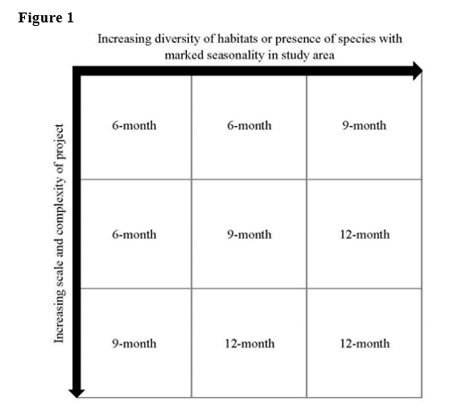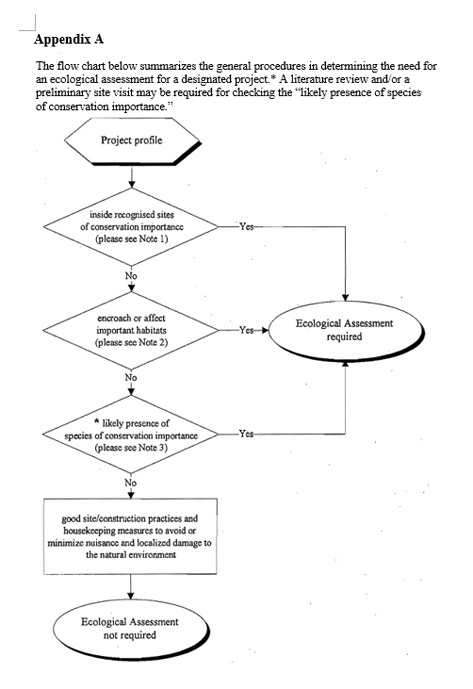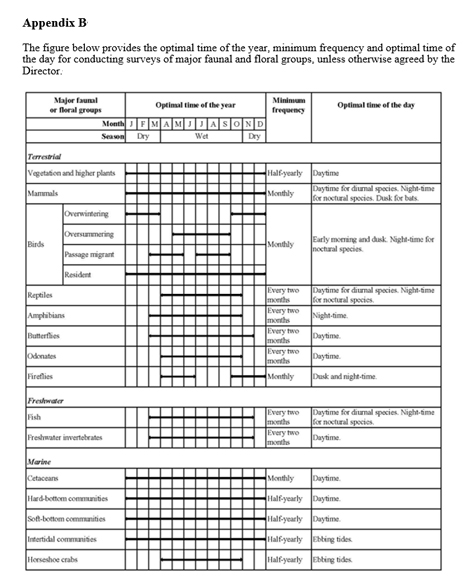Technical Memorandum
Annex 16
ANNEX 16 : GUIDELINES FOR ECOLOGICAL ASSESSMENT
1. Introduction
1.1 This Annex describes the general approach and methodology for assessment of ecological impact arising from a project.
1.2 An ecological assessment is part of an EIA study for a designated project which may have an impact on the natural environment including existing flora, fauna and wildlife habitats. The term "ecology" includes both marine and terrestrial ecology. The main objective of ecological assessment is to make an objective identification, prediction and evaluation of the potential ecological impacts, based on ecological information collected through literature review and samplings that are essential for evaluating the ecological impact in accordance with the criteria laid down in Annex 8 of this technical memorandum. The methodology used may vary from case to case depending on the natural environment to be affected and the nature and scale of the project.
2. The Need for Ecological Assessment
2.1 The procedures for determining the need for ecological assessment are outlined in Appendix A. The key factors to be considered are described in Notes 1 to 3 attached to Appendix A.
3. General Principle
3.1 The guiding principle for ecological assessment shall be that:
- areas and/or habitats of ecological importance (e.g. those listed in Note 1 and 2 of Appendix A) shall be conserved as far as possible. Any project that is likely to result in adverse ecological impacts in areas of ecological importance shall not normally be permitted unless the impacts can be minimized and/or compensated;
- both on-site and off-site impacts shall be identified and evaluated;
- both on-site and off-site mitigation measures shall be considered as integral parts of the EIA process;
- an applicant is required to mitigate any adverse environmental impacts arising from his project and to implement the necessary on-site and off-site measures. Where site constraints preclude the possibility of implementing on-site ecological mitigation measures, the feasibility of implementing off-site measures should be explored on a territory-wide basis;
- any mitigation measures shall be determined during the EIA study in accordance with the guidelines laid down in this technical memorandum, in particular this Annex and Annex 8.
4. The Scope and Content of Ecological
Assessment
4.1 An ecological assessment shall consist of 5 parts of equal importance:
- provision of comprehensive and accurate information on the ecological baseline;
- identification and prediction of potential ecological impacts;
- evaluation of the significance of the impacts identified;
- recommendations of effective and practicable alternatives and mitigation measures; and
- recommendations of the need for and the scope of ecological monitoring and audit programme.
5. Assessment Methodology
5.1 Ecological Baseline Information
5.1.1 The main objective of the baseline study of an ecological assessment is to provide adequate and accurate ecological baseline information of the proposed development and its vicinity for
- evaluation of the ecological importance of the flora, fauna and habitats found;
- identification, prediction and evaluation of impacts; and
- formulation of mitigation measures and monitoring programme.
5.1.2. The baseline study shall include at least the following:
5.1.2.1 Review of existing information
Existing information regarding the proposed development site and its vicinity shall be reviewed. Such information includes both published materials (books, journals, reports, registers, etc.) and those made available by government and non-government bodies. Due weight should be given to published data of recognized sources.
The accuracy and usefulness of the ecological information obtained must be carefully evaluated and verified before adopting its use in the ecological assessment report. Aspects such as time of survey (e.g. is the information out of date?), methodology, etc., shall be taken into account. Unless the information obtained is determined to be still valid, they shall be verified by on-site survey(s).
5.1.2.2 Habitat survey
A habitat map of suitable scale showing the various habitats of the site and its surrounding area (500 m from the site boundary or the area likely to be impacted by the project) shall be prepared. Characteristics of each habitat type shall be fully described with such information as species list, dominant flora and fauna found, presence of species of conservation importance, etc. Any habitat features of particular value to various ecological groups shall also be identified and described. Important habitats (Note 2 of Appendix A) shall be highlighted and described. Colour photos of each habitat type and any features of ecological importance identified shall be provided.
To ensure that the baseline information obtained is accurate, reproducible and can be easily verified, the methodology used must be clearly stated in the ecological assessment report. The methods employed must be sound and scientific. References shall be made to those standardized or accepted internationally. Results of survey shall be recorded in specifically designed standard forms wherever applicable. Data obtained shall be quantified and statistical analysis shall be applied wherever applicable.
5.1.2.3. Description of recognized
sites of conservation importance
All recognized sites of conservation importance (Note 1 of Appendix A) within, and in the vicinity of the proposed development site should be described. Whether these sites will be affected by the proposed development or not shall be assessed.
5.1.3 All field surveys carried out must not cause any unnecessary stress or damage to the existing habitats and wildlife. Relevant permits for collecting specimens must be obtained from the Agriculture, Fisheries and Conservation Department prior to the surveys. Results of all relevant field surveys, the names and relevant experience of the persons leading and conducting the surveys, shall be documented in field survey reports prepared, checked and signed by relevant professionals or experts.
5.1.4 To establish the ecological profile of the study area, an ecological baseline survey of at least 6-month and up to 12-month duration shall be conducted. The actual duration of such surveys shall be determined by considering the diversity of habitats of the study area, presence of species with marked seasonality, as well as scale and complexity of the project according to Figure 1 below.

5.15 The faunal and floral groups that are relevant to the study area should be determined through a review on the findings of relevant studies/surveys, or specified in the study brief. Optimal time of the year, minimum survey frequency and optimal time of the day for conducting the ecological baseline surveys shall be determined according to Appendix B, unless otherwise agreed by the Director.
5.16 The information gathered from the ecological baseline surveys shall be valid for 36 months upon their completion, after which the information should be verified through field surveys to confirm its validity for the purpose of ecological impact assessment.
5.2 Impact Identification and Prediction
5.2.1 Based on the project profile and ecological baseline information gathered, the ecological assessment shall identify and predict potential ecological impacts caused by the proposed development. There may be direct or primary impacts such as loss of habitats and loss of species. However many ecological impacts are induced or secondary such as loss of feeding grounds. Hence an ecosystem perspective highlighting the existing key relationships between different species and the surrounding environment shall be adopted.
5.2.2 An overlay of the project layout on the habitat map of the site (Section 5.1.2.2) shall be prepared to provide an overview of the impacts to local habitats.
5.2.3 All potential impacts, including direct, indirect, on site, off site, primary, secondary, induced, additional, synergistic, cumulative impacts, etc. shall be listed out. Suitable methodology such as checklists (descriptive, scaling, etc.), matrices, networks, features mapping, etc. shall be used and clearly stated whenever applicable. Predictions must be made with sound scientific basis.
5.3 Evaluation of Impacts
5.3.1 Impact significance is a product of the magnitude and scale of an impact and the asserted importance of the species or habitat(s) likely to be affected. However, it shall be noted that evaluating nature conservation interest is a difficult and complex process. Value or professional judgement is involved. Nevertheless the conservation value of a site or species and hence the significance of an impact shall be evaluated systematically using well defined criteria. The general criteria used are shown in Annex 8.
5.3.2 Impact significance shall be evaluated on a suitable geographical scale. The importance of the species or habitat(s) to be affected in the territory-wide scale should be considered.
5.4 Impact Mitigation
5.4.1 The general policy for mitigating impacts on important habitats and wildlife, in the order of priority, are :
- Avoidance
Potential impacts shall be avoided to the maximum extent practicable such as adopting suitable alternatives (e.g. change of site, design, construction method, alignment, layout, programme, etc.). In cases when the ecological assessment identifies significant impacts, modification of the project shall be considered first.
- Minimizing
In case the impacts could not be avoided, such impacts shall be minimized by practicable measures such as translocating important animal and plant specimens, confining works in specific area or season, restoration of disturbed areas, etc.
- Compensation
The loss of important species and habitats, if assessed to be significant, shall be compensated by measures such as re-provision of similar species/habitats or enhancement of existing habitats.
5.4.2 All mitigation measures recommended shall be feasible to implement within the context of Hong Kong. The effectiveness of the proposed mitigation measures shall be carefully evaluated and the significance of any residual impacts after implementing them shall be clearly stated.
5.4.3. From an ecological point of view, mitigation measures for ecological impact shall preferably be carried out on-site, and well in advance of the works rather than off-site, and after the completion of works.
5.4.4 Where off-site mitigation measures are involved, they shall be considered along with other alternatives e.g. change of site, layout, etc., including modifying the project.
5.4.5 The need for and the type and scope of the off-site ecological mitigation measures to be adopted for a particular project shall be determined according to the following guidelines:
- all relevant design measures and all practicable on-site ecological mitigation measures shall be investigated in the EIA study and exhausted to minimize the loss or the damage caused by the project to the ecological habitats or species;
- with the on-site ecological mitigation measures in place, the residual impacts on ecological habitats or species shall be defined, quantified and evaluated according to the methods and criteria laid down in this Annex and Annex 8. Before off-site ecological mitigation measures are to be adopted, the EIA study needs to confirm that it is necessary to mitigate the residual ecological impacts based on ecological considerations set out in this Annex and Annex 8, and that such residual impacts arise from the Project in question;
- if the residual ecological impacts require mitigation and all practicable on-site ecological mitigation measures have been exhausted, off-site ecological mitigation measures shall be provided;
- the off-site mitigation measures shall be on a "like for like" basis, to the extent that this is practicable. That is to say, any compensatory measures to be adopted for mitigating the residual ecological impacts must be directly related to the habitats or species to be protected. Either the same kind of species or habitats of the same size shall be compensated, or the applicant shall demonstrate that the same kind of ecological function and capacity can be achieved through the measures to compensate for the ecological impacts. For example, the loss of a natural woodland shall be compensated by the replanting of native trees to form a woodland of a similar size where possible;
- the off-site ecological mitigation measures shall only be implemented within the boundaries of Hong Kong, and must be technically feasible and practicable;
- the extent of such mitigation measures shall be limited to what is necessary to mitigate the residual ecological impacts arising from the project; and
- any proposed off-site mitigation measures shall not require further EIA study for their implementation. Their feasibility, constraints, reliability, design and method of construction, time scale, monitoring, management and maintenance shall be confirmed during the EIA study.
5.5 Ecological Monitoring and Audit Programme
5.5.1 The purposes of ecological monitoring and audit are :
- to verify the accuracy of the predictions of the ecological assessment study;
- to detect any unpredicted ecological impacts arising from the proposed development;
- to monitor the effectiveness of the mitigation measures; and
- to recommend action plans in response to unpredicted impacts, and/or failed mitigation.

Note 1 : Recognized Sites of Conservation
Importance
- existing or gazetted proposed Special
Areas
- existing or gazetted proposed Country
Parks
- existing or gazetted proposed Marine
Reserves
- existing or gazetted proposed Marine Parks
- Wild Animals Protection Area
- Sites of Special Scientific Interest
- Ramsar Site
- Inner Deep Bay and Deep Bay Buffer Zones
- any other areas declared by the Government as having special conservation importance
Note 2 : Important Habitats Where
an Ecological Assessment Will Be Necessary
An ecological assessment will be needed
if a proposed development will affect
- over one hectare of woodland
- over one hectare/500 metres of undisturbed natural coast
- over 0.5 hectare of intertidal mudflats
- established mangrove stands of any size
- over 0.5 hectare of freshwater or brackish marshes
- established seagrass (Zostera or Halophila or Ruppia species) bed of any size
- over 100 metres of natural stream courses and rivers of significant length
- over one hectare of wetlands (as defined by the Ramsar Convention) other than those mentioned in 2 to 7 above
- established coral communities of any size
- other habitats considered as having special conservation importance by documented scientific studies
Note 3 : Species of Conservation
Importance
An ecological assessment will be needed if the proposed development will affect habitats supporting significant population of wild fauna or flora that are :
- listed in Threatened Categories of IUCN Red List or those of the South China region;
- listed in international conventions for conservation of wildlife;
- endemic to Hong Kong or South China;
- listed under the legislation of Hong Kong:
- The Forestry Regulations (under the Forests and Countryside Ordinance, Cap. 96);
- The Wild Animals Protection Ordinance (Cap. 170);
- The Protection of Endangered Species of Animals and Plants Ordinance (Cap. 586);
- Other relevant ordinances or subsidiary legislation including but not limited to the Marine Parks and Marine Reserves Regulation (under the Marine Parks Ordinance, Cap. 476);
(References shall also be made to species protected by legislation in Mainland China, especially the Guangdong Province.)
- considered as rare in the territory or having special conservation importance by scientific studies other than those listed above.


|

